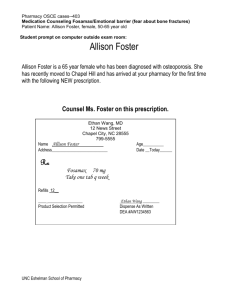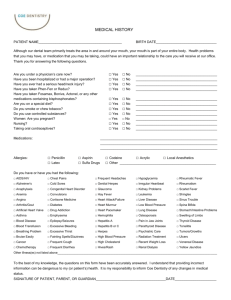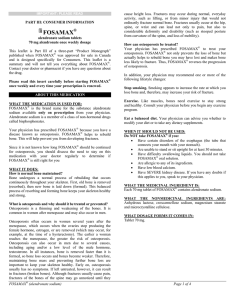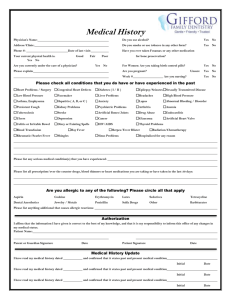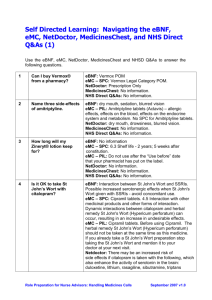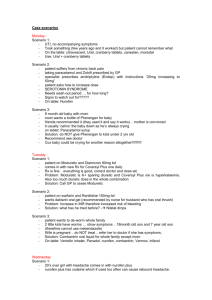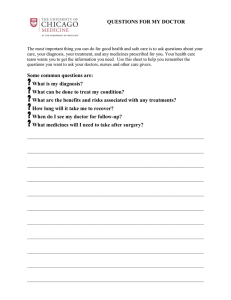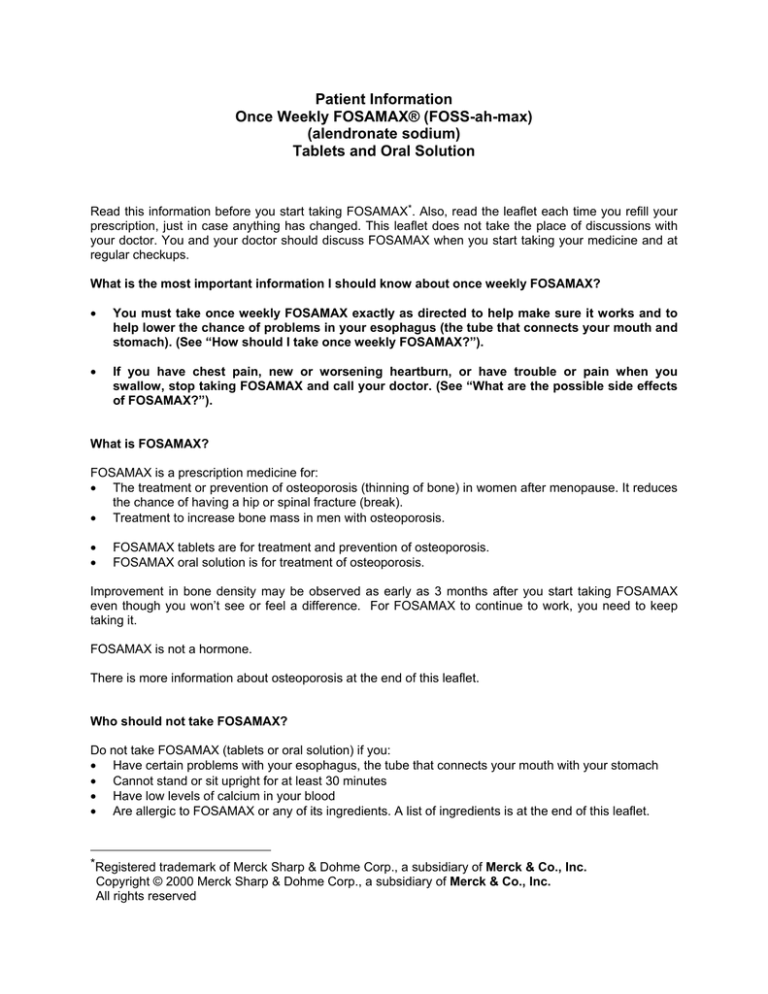
Patient Information
Once Weekly FOSAMAX® (FOSS-ah-max)
(alendronate sodium)
Tablets and Oral Solution
Read this information before you start taking FOSAMAX*. Also, read the leaflet each time you refill your
prescription, just in case anything has changed. This leaflet does not take the place of discussions with
your doctor. You and your doctor should discuss FOSAMAX when you start taking your medicine and at
regular checkups.
What is the most important information I should know about once weekly FOSAMAX?
•
You must take once weekly FOSAMAX exactly as directed to help make sure it works and to
help lower the chance of problems in your esophagus (the tube that connects your mouth and
stomach). (See “How should I take once weekly FOSAMAX?”).
•
If you have chest pain, new or worsening heartburn, or have trouble or pain when you
swallow, stop taking FOSAMAX and call your doctor. (See “What are the possible side effects
of FOSAMAX?”).
What is FOSAMAX?
FOSAMAX is a prescription medicine for:
• The treatment or prevention of osteoporosis (thinning of bone) in women after menopause. It reduces
the chance of having a hip or spinal fracture (break).
• Treatment to increase bone mass in men with osteoporosis.
•
•
FOSAMAX tablets are for treatment and prevention of osteoporosis.
FOSAMAX oral solution is for treatment of osteoporosis.
Improvement in bone density may be observed as early as 3 months after you start taking FOSAMAX
even though you won’t see or feel a difference. For FOSAMAX to continue to work, you need to keep
taking it.
FOSAMAX is not a hormone.
There is more information about osteoporosis at the end of this leaflet.
Who should not take FOSAMAX?
Do not take FOSAMAX (tablets or oral solution) if you:
• Have certain problems with your esophagus, the tube that connects your mouth with your stomach
• Cannot stand or sit upright for at least 30 minutes
• Have low levels of calcium in your blood
• Are allergic to FOSAMAX or any of its ingredients. A list of ingredients is at the end of this leaflet.
*Registered trademark of Merck Sharp & Dohme Corp., a subsidiary of Merck & Co., Inc.
Copyright © 2000 Merck Sharp & Dohme Corp., a subsidiary of Merck & Co., Inc.
All rights reserved
9635610
Do not take FOSAMAX oral solution if you have trouble swallowing liquids.
What should I tell my doctor before using FOSAMAX?
Tell your doctor about all of your medical or dental conditions, including if you:
•
•
•
•
•
have problems with swallowing
have stomach or digestive problems
have kidney problems
are pregnant or planning to become pregnant. It is not known if FOSAMAX can harm your unborn
baby.
are breastfeeding. It is not known if FOSAMAX passes into your milk and if it can harm your baby.
Tell your doctor about all medicines you take, including prescription and non-prescription medicines,
vitamins, and herbal supplements.
Know the medicines you take. Keep a list of them and show it to your doctor and pharmacist each time
you get a new medicine.
How should I take once weekly FOSAMAX?
•
Choose the day of the week that best fits your schedule.
•
Take 1 dose of FOSAMAX every week on your chosen day after you get up for the day and before
taking your first food, drink, or other medicine
•
Take FOSAMAX while you are sitting or standing.
•
Take your FOSAMAX with plain water only as follows:
•
•
TABLETS: Swallow one tablet with a full glass (6-8 oz) of plain water.
ORAL SOLUTION: Drink one entire bottle of solution followed by at least 2 ounces (a quarter of a
cup) of plain water.
Do not take FOSAMAX with:
Mineral water
Coffee or tea
Juice
FOSAMAX works only if it is taken on an empty stomach.
Do not chew or suck on a tablet of FOSAMAX.
After taking your FOSAMAX, wait at least 30 minutes:
● before you lie down. You may sit, stand or walk, and do normal activities like reading.
● before you take your first food or drink except for plain water.
● before you take other medicines, including antacids, calcium, and other supplements and vitamins.
Do not lie down until after your first food of the day.
•
It is important that you keep taking FOSAMAX for as long as your doctor says to take it. For
FOSAMAX to continue to work, you need to keep taking it.
2
9635610
What should I do if I miss a dose of FOSAMAX or if I take too many?
•
If you miss a dose, take only 1 dose of FOSAMAX on the morning after you remember. Do not take 2
doses on the same day. Continue your usual schedule of 1 dose once a week on your chosen day.
•
If you think you took more than the prescribed dose of FOSAMAX, drink a full glass of milk and call
your doctor right away. Do not try to vomit. Do not lie down.
What should I avoid while taking FOSAMAX?
•
Do not eat, drink, or take other medicines or supplements before taking FOSAMAX.
•
Wait for at least 30 minutes after taking FOSAMAX to eat, drink, or take other medicines or
supplements.
•
Do not lie down for at least 30 minutes after taking FOSAMAX. Do not lie down until after your first
food of the day.
What are the possible side effects of FOSAMAX?
FOSAMAX may cause problems in your esophagus (the tube that connects the mouth and
stomach). (See “What is the most important information I should know about once weekly FOSAMAX?”.)
These problems include irritation, inflammation, or ulcers of the esophagus, which may sometimes bleed.
This may occur especially if you do not drink a full glass of water with FOSAMAX or if you lie down in less
than 30 minutes or before your first food of the day.
•
Stop taking FOSAMAX and call your doctor right away if you get any of these signs of
possible serious problems of the esophagus:
•
•
•
Chest pain
New or worsening heartburn
Trouble or pain when swallowing
•
Esophagus problems may get worse if you continue to take FOSAMAX.
•
Mouth sores (ulcers) may occur if the FOSAMAX tablet is chewed or dissolved in the mouth.
•
You may get flu-like symptoms, typically at the start of treatment with FOSAMAX.
•
You may get allergic reactions, such as hives or, in rare cases, swelling of your face, lips, tongue, or
throat.
•
FOSAMAX may cause jaw-bone problems in some people. Jaw-bone problems may include
infection, and delayed healing after teeth are pulled.
•
The most common side effect is stomach area (abdominal) pain. Less common side effects are
nausea, vomiting, a full or bloated feeling in the stomach, constipation, diarrhea, black or bloody
stools (bowel movements), gas, eye pain, rash that may be made worse by sunlight, hair loss,
headache, dizziness, a changed sense of taste, joint swelling or swelling in the hands or legs, and
bone, muscle, or joint pain.
•
Call your doctor if you develop severe bone, muscle, or joint pain.
3
9635610
•
Some patients have experienced fracture in a specific part of the thigh bone. Call your doctor if you
develop new or unusual pain in the hip or thigh.
Tell your doctor about any side effect that bothers you or that does not go away.
These are not all the side effects with FOSAMAX. Ask your doctor or pharmacist for more information.
How do I store FOSAMAX?
•
•
•
Store at room temperature, 59 to 86°F (15 to 30°C).
Safely discard FOSAMAX that is out-of-date or no longer needed.
Keep FOSAMAX and all medicines out of the reach of children.
General information about using FOSAMAX safely and effectively
Medicines are sometimes prescribed for conditions that are not mentioned in patient information leaflets.
Do not use FOSAMAX for a condition for which it was not prescribed. Do not give FOSAMAX to other
people, even if they have the same symptoms you have. It may harm them.
FOSAMAX is not indicated for use in children.
This leaflet is a summary of information about FOSAMAX. If you have any questions or concerns about
FOSAMAX or osteoporosis, talk to your doctor, pharmacist, or other health care provider. You can ask
your doctor or pharmacist for information about FOSAMAX written for health care providers. For more
information, call 1-877-408-4699 (toll-free) or visit the following website: www.fosamax.com.
What are the ingredients in FOSAMAX?
Tablets
FOSAMAX tablets contain alendronate sodium as the active ingredient and the following inactive
ingredients: cellulose, lactose, croscarmellose sodium and magnesium stearate.
Oral Solution
Fosamax oral solution contains alendronate sodium as the active ingredient and the following inactive
ingredients: sodium citrate, citric acid, sodium saccharin, artificial raspberry flavor, purified water, sodium
propylparaben and sodium butylparaben.
What should I know about osteoporosis?
Normally your bones are being rebuilt all the time. First, old bone is removed (resorbed). Then a similar
amount of new bone is formed. This balanced process keeps your skeleton healthy and strong.
Osteoporosis is a thinning and weakening of the bones. It is common in women after menopause, and
may also occur in men. In osteoporosis, bone is removed faster than it is formed, so overall bone mass is
lost and bones become weaker. Therefore, keeping bone mass is important to keep your bones healthy.
In both men and women, osteoporosis may also be caused by certain medicines called corticosteroids.
At first, osteoporosis usually has no symptoms, but it can cause fractures (broken bones). Fractures
usually cause pain. Fractures of the bones of the spine may not be painful, but over time they can make
you shorter. Eventually, your spine can curve and your body can become bent over. Fractures may
4
9635610
happen during normal, everyday activity, such as lifting, or from minor injury that would normally not
cause bones to break. Fractures most often occur at the hip, spine, or wrist. This can lead to pain, severe
disability, or loss of ability to move around (mobility).
Who is at risk for osteoporosis?
Many things put people at risk of osteoporosis. The following people have a higher chance of getting
osteoporosis:
Women who:
•
Are going through or who are past menopause
Men who:
•
Are elderly
People who:
• Are white (Caucasian) or oriental (Asian)
• Are thin
• Have family member with osteoporosis
• Do not get enough calcium or vitamin D
• Do not exercise
• Smoke
• Drink alcohol often
• Take bone thinning medicines (like prednisone or other corticosteroids) for a long time
What can I do to help prevent or treat osteoporosis?
In addition to FOSAMAX, your doctor may suggest one or more of the following lifestyle changes:
Stop smoking. Smoking may increase your chance of getting osteoporosis.
Reduce the use of alcohol. Too much alcohol may increase the risk of osteoporosis and injuries
that can cause fractures.
• Exercise regularly. Like muscles, bones need exercise to stay strong and healthy. Exercise
must be safe to prevent injuries, including fractures. Talk with your doctor before you begin any
exercise program.
• Eat a balanced diet. Having enough calcium in your diet is important. Your doctor can advise
you whether you need to change your diet or take any dietary supplements, such as calcium or
vitamin D.
•
•
Rx only
Merck Sharp & Dohme Corp., a subsidiary of Merck & Co., Inc.
Whitehouse Station, NJ 08889, USA
Issued March 2010
5

